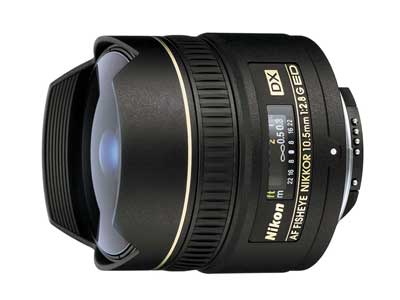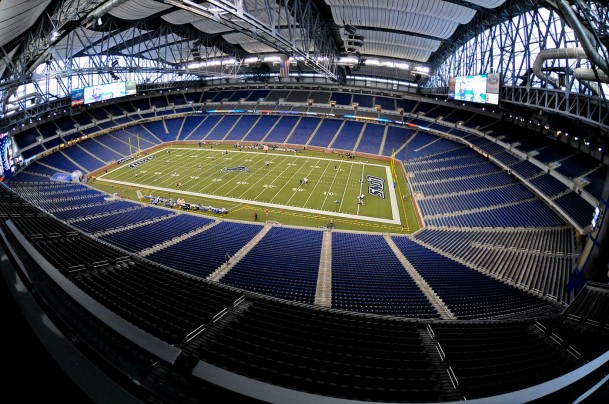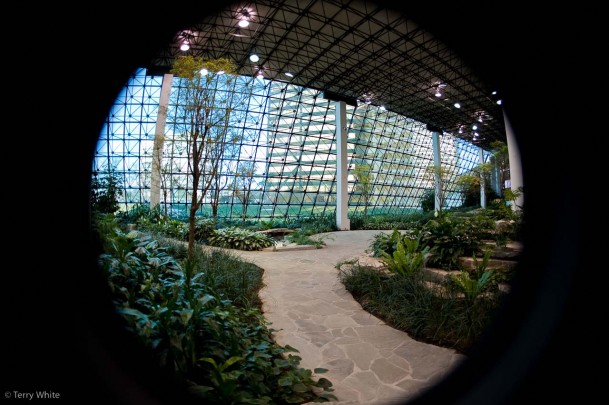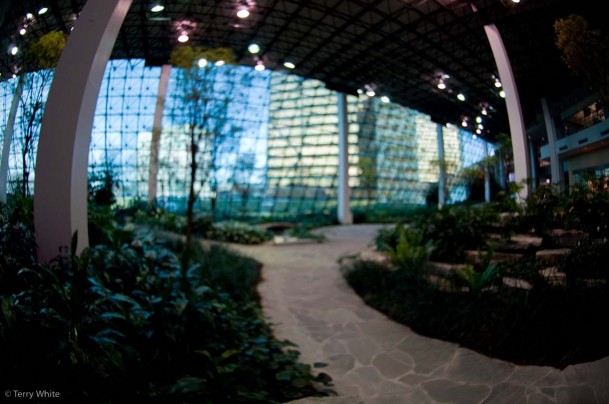Above photo of Ford Field shot by Scott Kelby using a Nikon 10.5mm f/2.8 lens on a D3 body
During a recent visit by my buddy Scott Kelby who came up to shoot the Lions vs. the Bears game, he showed me this shot that he took with his Nikon 10.5mm f/2.8 lens on his Nikon D3. Honestly, I was never really a fan of fisheye shots before but there was something about this one that made me say "cool!"
My search for a fisheye lens began
Now keep in mind that for me a fisheye lens is something that I would use on occasion at best. It's not something that I would use every day and even Scott said, "you will probably use it the least" when I was asking "what should be my next lens?" Keeping that in mind I was debating between the Nikon 10.5mm f/2.8 DX fisheye lens and the Nikon 16mm f/2.8 EX fisheye lens. The difference is that the 16mm Fisheye lens is designed for full frame bodies like my D700. The 10.5mm Fisheye is a DX lens for Bodies with a cropped sensor like a D300s. There is about a $300 price difference between the two and I figured since I wouldn't be using it that often and when I do it will probably be on my D5000, so I decided to go the 10.5mm.
note: click on any of the shots in this post to see them larger
The Sigma 15mm f/2.8 detour
When I went to order my Nikon 10.5mm lens (still debating the 16mm), it wasn't in stock. So as an alternative it was suggested that I try the Sigma 15mm f/2.8 Fisheye Lens. Since they had no problem taking it back if I didn't like it, I decided to give it a shot (get it, "give it shot", c'mon these are the jokes people).
A serious WTF moment:
I got the lens and put it on my D700 and fired. Here's what I got:
Umm, What? I felt like I was shooting through a hole. Granted, this may be cool for somethings, but I can do that in Photoshop. What makes matters worse it wouldn't work with my D5000 at all. The camera wouldn't even come on with that lens attached. So back in the box it went. Thanks, but not quite what I had in mind. Now I know that there is probably software out there designed to correct these images and make them look, um right. However, I don't feel that I should have to process every single image that comes out of my camera using special software and the fact that it wouldn't work at all on the D5000 was a deal breaker anyway.
The Nikon 10.5 mm Fisheye Lens vs. the Nikon 16mm Fisheye Lens
So back to the real debate. I was back to which one to get and I decided on the 10.5mm Fisheye Lens because for what I plan to do with it, the price difference just wasn't worth it. However, just to make sure and to give you guys some real world shots to see the difference, I rented the 16mm from LensPro To Go.com for a week to really see the difference. So here goes:
Nikon 10.5mm Fisheye shot on a D700 at f/2.8, ISO 200, Aperture Priority
Nikon 16mm Fisheye shot on a D700 at f/2.8, ISO 200, Aperture Priority
Then the Tripod police showed up
OK everything was going good during this test shoot until, yep you guessed it, the Tripod Police showed up. "Sir you're not allowed to take pictures here." So the next two shots were taken with the D5000. However, they were taken literally as I was packing up and since the D5000 requires Nikon AF-S lenses to AUTOFOCUS (neither the 10.5mm or 16mm lenses are AF-S lenses), I couldn't focus these by looking through the view finder for fear of being tackled. So these are out of focus for that reason and not the fault of the lens. (This is definitely something to keep in mind when choosing a lens for a consumer body. See compatibility the lens compatibility links at the end of the post.) However, the main purpose here was to show what you get with a cropped sensor on each lens. So the focus issue wasn't my main concern for this test.
Nikon 10.5mm Fisheye shot on a D5000 at f/2.8, ISO 200, Aperture Priority
I got a little luckier here with the focus as the focus ring just happened to be closer to where it needed to be. This was a quick lens swap as I pretended to be taking everything down. 🙂
Nikon 16mm Fisheye shot on a D5000 at f/2.8, ISO 200, Aperture Priority
Just for fun
I also recently got the ("dream lens") Nikon 14-24mm f/2.8 Wide Angle Lens. So I thought I would give you a comparison of the above Fisheye shots against this "dream" wide angle lens too. I got these two shots before the Tripod Police showed up.
Nikon 14-24mm Wide Angle Lens shot on a D700 at f/2.8, 14mm, ISO 200, Aperture Priority
Nikon 14-24mm Wide Angle Lens shot on a D5000 at f/2.8, 21mm equivalent, ISO 200, Aperture Priority
The Bottom Line

I'm happy with my choice of the Nikon 10.5mm Fisheye Lens. If you plan to use one of these primarily on a full frame body, then you might want to look at the 16mm Fisheye. If you really aren't sure even after this post as what will work best for you, spend a few bucks over at lensprotogo.com and rent the ones you're thinking about and they you can see them side-by-side.
Note: When using a cropped sensor lens (DX) on a full frame body like the D700 or D3 your image will be cropped down to about 6MP (2784×1848) instead of the full 12MP (4256×2832) supported by your full frame camera. So if you really want the full resolution of your camera then you should go with a full-frame lens.
Here are a few links to help you out:
The Nikon 10.5mm f/2.8 ED DX Fisheye Lens goes for $695 here.
The Nikon 16mm f/2.8 Fisheye Lens goes for $930 here.
The Nikon 14-24mm f/2.8 ED Wide Angle Lens goes for $1,825 here.
The Sigma 15mm f2.8 EX Fisheye Lens goes for $609 here.
The Nikon D700, D3s and D5000.










I was a long-time user of the 10.5 with my old D100 and D2x. After I went full-frame, I splurged on the 16mm for the D3. I was extremely disappointed with the 16. For the type of photography I do, I use a fisheye a lot; I think they are a lot of fun and are amazingly easy to focus, even in close-up party-like situations.
But comparing them is a very esoteric thing in my opinion. I have found that the 16 just isn’t as “curvy” as the 10.5, and the effect is not nearly as distorted, which is really why I use a fisheye. While your comparison shots above are helpful, you also have to point the lenses down and up in situations like that to appreciate more the distortion and clarity at the edges. I don’t think it’s fully apparent in your photos. While there is a measurement for the angle (16 degrees vs. 10.5), there isn’t a measurement for “curviness”, or what I think is the depth of the fisheye bubble. I like more of a bubble (like the 10.5), and others may like less (like the 16). But they are clearly not the same. Perhaps another word for “curviness” is “fishyness”.
The 10.5 is the single thing I miss the most about switching to full-frame. I could use it in DX mode of course, but then you lose some mp’s.
I bought the Sigma full-fisheye, too, and while it is fun, I almost never use it. Again, even though the angle is more full, it is strangely not as curvy.
This is not a very scientific analysis, I know, but that is my impression! Thanks for the review Terry.
Terry,
I use my 10.2 fisheye from Nikon and use is all the time, great lens. I use in my real estate photography doing 360 pano on a tripod. this 360 pano of Keenland race track where I live in Lexington, KY using the nikon 10.5. http://www.kblawson.com/walkabout2-Edit.html
Question: I am in the process of going Mac (scared about this), what do you suggest is the ample specs to run the Creative suite CS4 on a macbook or macbook pro and and not have it be sluggish or hang? 85% of use is photoshop extendedCS4.
thanks
Ken in KY
Terry
Corrections the Nikon is a 10.5mm not 10.2mm.
Ken
Ken, check this link out.. this bloke knows all that needs to be known about Mac and PS/CS4. http://macperformanceguide.com/
Whatever you buy, buy only the memory that comes with it and go to crucial for any additional memory you want/need. It is very easy to install and will save 50-200%.
Terry —
Re: the Sigma 15mm — since the Sigma is a crop-sensor lens (like the Nikon DX lenses), wouldn’t you need to set your D700 for DX format?
That is, if you attach a Nikon-brand DX lens, your D700 automatically detects it* and crops to show only the DX-size image. But with other brand lenses, you have to set that manually, in Shooting Menu -> Image area -> Choose image area -> DX format. Unless I’m missing something.
Also, did you mention that DX lenses (like the Nikon 10.5mm) will give you only a 6 MP image on the D700? If all other things are roughly equal, I think I might pay the extra $300 for the full 12 MP image from my fisheye shots.
-=-Joe
*If you’ve set Shooting Menu -> Auto DX crop to ON.
Joe, that’s just it. I was told that that the Sigma 15mm EX is supposedly a Full-Frame lens:
http://www.bythom.com/15lens.htm
So I didn’t think I should have to set my camera to crop sensor mode.
If in fact it’s not a Full Frame lens then the price is way out of whack as you can get the Nikon 10.5 cropped sensor lens for the same money. Also if it’s not a Full Frame lens then I’m even happier that I returned it as it didn’t work with my D5000 and the Nikon 10.5 does and the 10.5mm works on my D700 without having to change any settings manually.
Yes, good point on the 6MP image on the D700 and yes if you want the full 12MP you would have to go with the 16mm (I will add it to the post). However, for the effects I want and what I plan to shoot with it, I still prefer the 10.5mm even on the D700. I have updated the post with this info.
Wow, the Sigma’s a *terrible* full-frame lens! Kinda shocking.
Oh, and I’ve had those tripod police events too many times to count. I really like how you kept sneaking shots as you broke down your setup. Now that’s dedication!
More info (according to Sigma the 15mm DG EX Fisheye is a FULL FRAME lens):
Direct link to the Sigma lens:
http://www.sigmaphoto.com/lenses/lenses_all_details.asp?id=3279&navigator=4
Sigma’s Nomenclature
EX – EX Lens. Denotes superior build and optical quality (similar to Canon’s “L” and Nikon’s “G” specification).
DG – For full-frame digital and 35mm film cameras. The image circle on these lenses are suitable for full-frame digital and 35mm film cameras. Sigma has concentrated on the correction of distortion and aberrations.
DC – For cropped sensor digital cameras including APS-C and Four Thirds. The image circle on these lenses match the smaller size of image sensor on small-frame sensor cameras (DX-format on Nikon, EF-S on Canon).
HSM – Hyper-Sonic Motor. HSM lenses use a motor driven by ultrasonic waves to provide quiet fast AF, Sigma’s version of Canon’s in-lens ultrasonic motor. HSM makes autofocus faster and facilitates simultaneous use of manual and
If you are going to use the Nikkor 10.5mm fisheye lens on an FX camera, you should get the lens hood removed to allow you the option to use the larger sensor in FX mode, not DX crop mode. 360pano.de did a terrific job for me, or there are a number of websites for do it yourself lens surgery (Google ‘shaving hood Nikon 10.5’).
Thanks for the link to 360pano!
Terry,
Something doesn’t make sense here… I’m a salesperson at B&H – I deal with those lenses all day.
The ‘tunnel effect’ you got looks like what you would get from a circular fisheye (such as the Sigma 4.5mm). These lenses give you a tremendous field of view, but expose only the center circle of the sensor leaving everything else black (like your picture). All the lenses you tried are linear fisheyes, which expose the entire sensor giving a regular edge-to-edge image.
The Sigma 15mm, being a linear fisheye, should give you a picture similar to the ones you got from the Nikon lenses. I actually just tried the Sigma with both the D700 (both FX and DX crop mode) and D5000 and it worked perfectly fine. Of course with the D700 (DX mode), you get more ‘curviness’ due to the greater field of view. So I’m not really sure why you got such weird results…
Morris,
I’m glad to know that what I got was not the way it was supposed to work. I was trying to figure out why anyone would buy this lens. So I’m relieved to know that something was wrong. The question is what? I took the lens out of the box tried it on both bodies and you see what I got. I didn’t try the FX/DX crop on the D700 because I figured I shouldn’t have to. So maybe something was funky with the lens I received as it wouldn’t work on my D5000 at all. In any case I’m quite happy with the service I got from B&H and even more happy with my Nikon 10.5mm. The Sigma is on it’s way back via RMA, perhaps you guys can try it out?
Terry,
I’m in sales, so I don’t have access to returns, and can’t really know if that particular one was a dud or not. But it definitely looks like it was… I just experimented with the D700 again and couldn’t think of any setting that would give you results like the ones you got. Same with the D5000.
But at the end of the day, you’d probably be happier with the Nikon 10.5, since the Sigma doesn’t give you that much of a fisheye effect on the D5000 (just the D700). The Nikon, on the other hand, would give you the same ‘curviness’ on both cameras (albeit with less resolution on the D700).
Good luck, and glad you’re happy with our service!
Love the Nikon 10.5. Here is a shot I took of the Georgia Dome the Friday before the Supercross.
http://farm4.static.flickr.com/3042/2311993115_6cbe5c330c.jpg
Awesome shot! Thanks for the inspiration!
I have the sigma for canon and mine has a removable metal sleeve around the lens barrel. When this is removed, simply by sliding it off, it allows the lens full range.
hmmmm, that might be the trick. I can’t test it now because I’ve already returned it. However, I’ll check with B&H to see if this is the case. Thanks for the tip.
Hi Terry,
I recognize that indoor garden from Tower 2000!
My wife works in that building.
I always thought that area was very cool.
Maybe I’ll bump into you one of these days while I’m there doing network support.
Take it easy,
Mark
DISCLAIMER: My knowledge comes from internet searches, not personal experience. I found this post in my attempt to learn more on the subject. With that said…
Re: “I was trying to figure out why anyone would buy [a circular fisheye] lens.”
In a sentence, circular fisheye lenses create higher-quality, faster virtual reality panoramas. It’s a small slice of photography but circular fisheyes work very well.
The linear fisheye lenses, such as the two Nikon lenses, only capture the 180 degree field of view across the diagonal of a frame. After you do the math (a-squared plus b-squared equals 180), which varies from lens to lens, you’ll have less than 180 degree field of view from left to right and just above a 90 degree field of view from top to bottom. A circular fisheye lens captures 180 degree field of view both horizontally and vertically for a full 180 degree hemisphere.
This is oversimplifying, but open up Photoshop and take a look at Filters > Distort > Spherize. Change the mode from Normal (which simulates the effect of a circular fisheye) to Horizontal Only (simulates linear) to get a feel for the idea.
On a practical level, take a look at Ken’s great shots from his post on January 21 above. Linear fisheyes like the Nikons do a fine job of making those virtual reality views, but notice that there isn’t a lot of sky or ground information (you can’t look straight up or straight down). That’s because it’s a pain to stitch together the sky and ground with linear fisheyes (it can be done, it’s just more difficult and/or time consuming).
The circular fisheye lens already has the sky and ground information built into each shot. There’s more distortion fixing involved (which software does with ease) and a lot less manual stitching/photoshopping. The results are faster and less “flat”. It’s much more difficult to notice the “edges” of the VR box. If these last two sentences don’t make sense, don’t worry about it. If you want them to make sense, check out the technical link below.
So if the absolute fullest context of a stitched pano is important (say, a full 360 degree VR of a wedding chapel to get everybody plus the chapel, or the full interior of an apartment or house to be rented/sold) it’s wise, in the long run, to get a circular fisheye. Time spent stitching linear shots is money lost. But if your intent is to get the single curvy shot, don’t plan on doing any VR, don’t need the full contextual environment in your VR, or don’t mind spending the extra stitching time, a linear fisheye will do the trick.
For more general info on types of fisheyes, check out wikipedia:
http://en.wikipedia.org/wiki/Fisheye_lens
For an example of typical linear VR, take a look at Ken’s example posted above.
For an intro to technical aspects of full panoramas and an example of a typical circular VR, take a look at this great article (click on the Roger’s Center image for the VR example):
http://www.rosaurophotography.com/html/technical.html
Hope that helps!
Thanks for the post! I was looking for an article to find out if either the 10.5 or the 16 were circular and your examples were very helpful. I love that you actually got your hands on some lenses and posted example shots. So many other blogs simply attempt to describe what an example shot would look like. Thanks for taking the extra step! 🙂
Thanks Terry. Great comparison. I’ve been using the 10.5 for years with a variety of DX bodies and love every minute of it. Now, I’m upgrading to the D800 and FX, but it seems like I might save myself a cool $1000 and just keep using my 10.5 on cropped mode. With 33.5mp on the D800, I can probably afford to lose a few pixels…
Glad to find this article … I already have the 10.5mm Nikon, but am going to be moving to a full-frame (D810) from my current APS-C sensor D300 body … I don’t use the fisheye a lot but it has been fun / useful in some situations … I cannot really justify getting the 16mm Nikon to replace it when I see that it will function (albeit in a cropped mode) on the full-frame bodies.